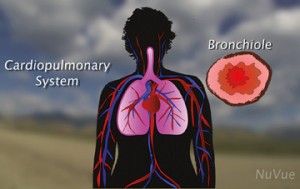Exercise and Asthma
Posted on October 4, 2014 by bob in Moving Free
Asthma is a chronic disease of the airways. It causes bronchial passages to become inflamed and narrowed in response to  triggers including cold, exercise, stress, and allergens such as dust mites, dander and smoke. Breathing becomes labored and difficult, and in extreme cases, asthma attacks can be fatal. Asthma is on the rise. It affects about 25 million people in the US according to he National Institutes of Health.
triggers including cold, exercise, stress, and allergens such as dust mites, dander and smoke. Breathing becomes labored and difficult, and in extreme cases, asthma attacks can be fatal. Asthma is on the rise. It affects about 25 million people in the US according to he National Institutes of Health.
There are many types and degrees of asthma. The most common symptoms are wheezing, shortness of breath and coughing.
There is no cure, but modern medicine has provided options that help keep most asthma symptoms under control, most of the time. They include drugs, swallowed, inhaled and injected, and lifestyle changes like diet and exercise. People with asthma can exercise, but exercising with asthma is a two-edged sword.
Exercise is an irritant trigger. It can induce asthma. In fact, there is a whole category of asthmatics for which exercise induced asthma, EIA for short, is the main issue. However this can be overcome. Studies show that exercising for fitness, particularly aerobic exercise, strengthens and builds the cardiovascular and pulmonary systems to the same extent as it does in non-asthmatics. Asthmatics can become very fit. Many Olympic and professional athletes have exercise-induced asthma.
If your doctor says you can exercise, pick an exercise that gets your heart rate up without putting too much pressure on your breathing. Generally, low intensity activities such as walking, biking, moderate aerobics, and swimming outdoors where fumes from pool chemicals are less of an irritant, are more easily tolerated. Some asthmatics have trouble with even low intensity exercise, while others can do almost anything most of the time. Here are some tips to consider:
— consult your doctor before you begin;
— avoid triggers whenever possible (if it’s too cold or the pollen count is high, exercise indoors);
— keep your emergency inhaler handy just in case;
— if exercise feels too intense, stop or slow down;
— try pursed lipped breathing, breathing in through the nose and out through the mouth, to help airways relax.
The bottom line is exercising with asthma is a very individual undertaking. One size does not fit all. Ease in, stay in your comfort zone, start gently and build up intensity over time.
 Mirabai Holland, M.F.A. is a public health activist and authority in the Health & Fitness industry, specializing in preventive and rehabilitative exercise. Her Moving Free® approach to exercise is designed to provide a movement experience so pleasant it doesn’t feel like work. www.mirabaiholland.com.
Mirabai Holland, M.F.A. is a public health activist and authority in the Health & Fitness industry, specializing in preventive and rehabilitative exercise. Her Moving Free® approach to exercise is designed to provide a movement experience so pleasant it doesn’t feel like work. www.mirabaiholland.com.









